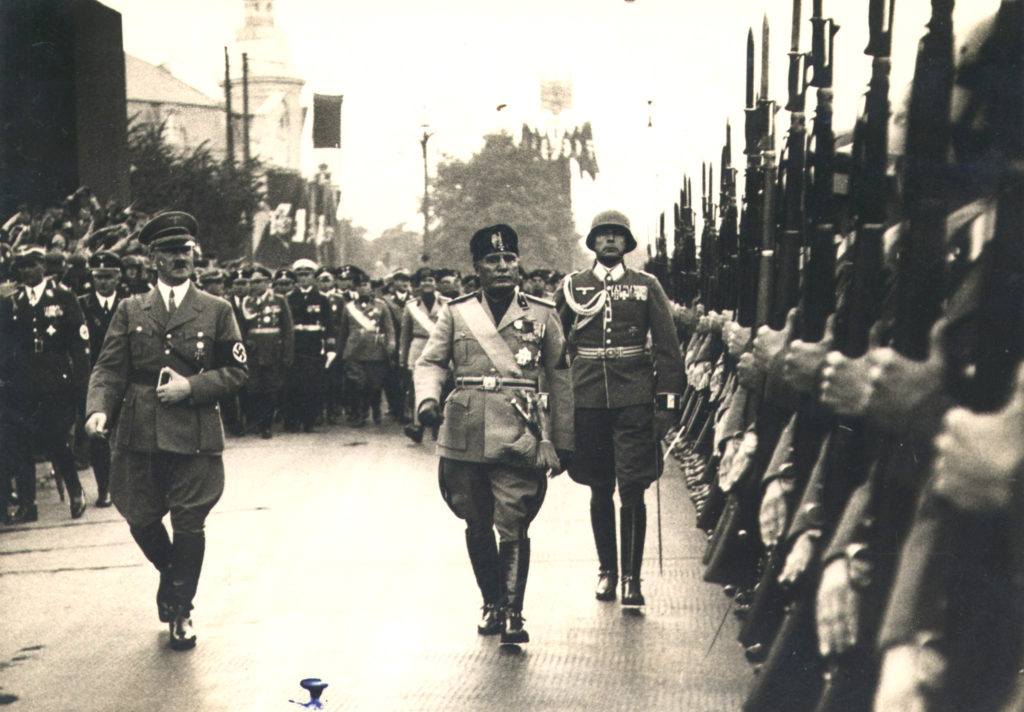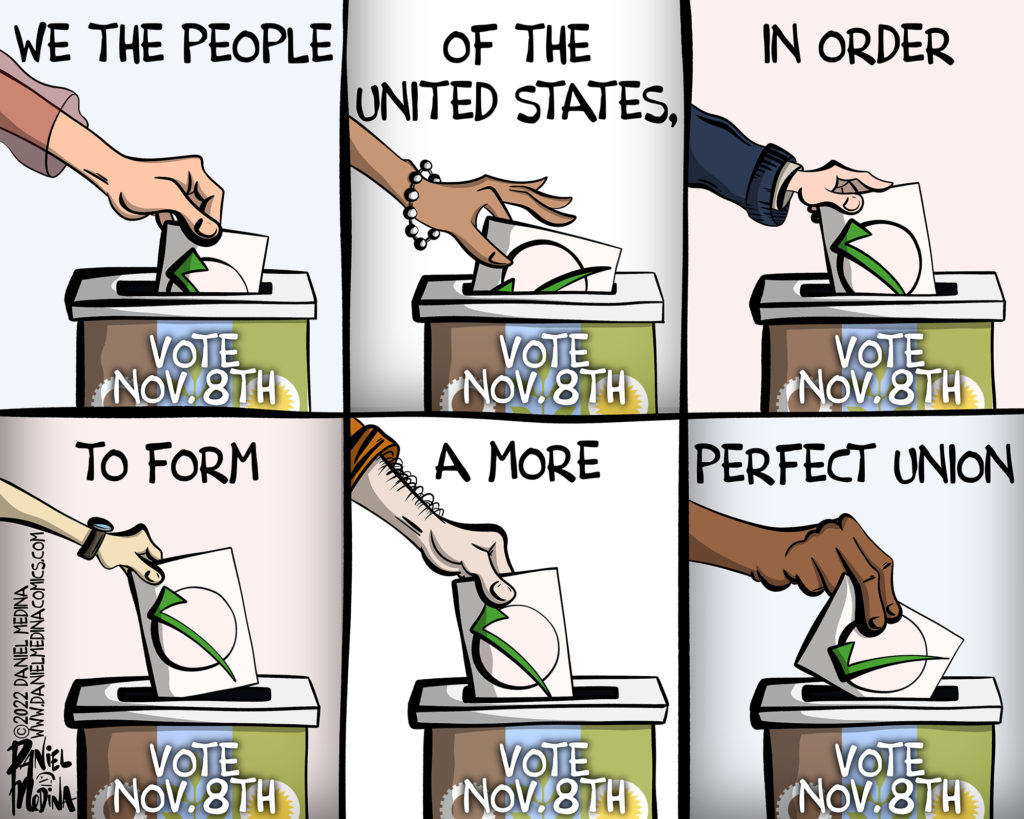
Elections are always about the future. The party that wins tries to mold the future to their values and ideals. Some current issues America faces include the climate crisis, voter suppression, conspiracy theories, inflation causing higher prices, the risk of a recession, rising gas prices, abortion and LGBTQ+ rights. Those issues will all be affected by the outcome of the upcoming election.
To a large extent though, those are actually minor issues. In the midterm election, the main issue Americans will be voting on is whether America remains a democracy or becomes a complete fascist state. Since at least October 1805, Americans have heard the phrase, “This election is the most important of our lifetimes.” This year it is true.
On Aug. 25, President Biden referred to the MAGA philosophy and the support of Trump as being “like semi-fascism.” Many Republicans took offense at being linked to fascism. There are valid reasons to call Republicans fascists.
The terms fascist and fascism have been cited in dictionaries since 1919 when Benito Mussolini first conceived the term fascism to describe his Italian political movement.
Some authors believe the tenets of fascism in America go back to the 1850s’ “Know Nothing” movement, which was a nativist, anti-immigrant, anti-Catholic, antisemitic movement. In any case, fascism has been a presence on the American political landscape since the 1920s.
In the 1930s, there were several prominent Americans who were Nazi sympathizers (e.g., Father Coughlin, Charles Lindbergh, Henry Ford and Los Angeles Times publisher Norman Chandler). There were also organizations, such as the German American Bund, espousing fascist ideology. They were considered a small but vocal minority of Americans.

After World War II, proponents of fascism receded from the American political scene although some of its right-wing tenets, such as White supremacy and anti-immigrant policy, remained in organizations like the John Birch Society of the 1950s.
The revival of fascism in America began slowing after the passage of the 1964 Civil Rights Act. Southern Democrats who advocated for White supremacy left the Democratic Party.
As part of Nixon’s “Southern Strategy,” they began to join the Republican Party. By 2009, under the influence of its Tea Party, the Republican Party had grown a strong White nationalist wing.
Starting in 2011, the first of numerous articles began to appear on how the Republican Party was becoming a cult. Cults are often an integral part of fascism. With the election of Trump in 2016, the Republican Party met almost all the criteria to be called a cult.
In 2018, Trump had assumed complete control of the Republican Party. At the same time, the Republican Party assumed most of the characteristics of fascism. No longer were Republicans voting based on a candidate’s ethics, integrity, morals, voting history or legislative accomplishments. They were voting solely on the basis of loyalty to Trump and Trump’s Republican Party.
What is fascism? Historians, political scientists and other scholars have written many books and articles trying to define the core tenets of fascism. However, there is no universally accepted, easy-to understand and clear definition of fascism.
On June 22, 1995, the New York Review of Books published a classic article on fascism by cultural theorist Umberto Eco. Eco listed 14 general properties of fascist ideology.
Eco listed “features that are typical of what I would like to call Ur-Fascism, or Eternal Fascism.
“These features cannot be organized into a system; many of them contradict each other, and are also typical of other kinds of despotism or fanaticism. But it is enough that one of them be present to allow fascism to coagulate around it.”
Eco’s premise is that not all the traits are needed for an individual, a political party or a country to be labeled a fascist.
Almost all authors agree that fascism is difficult to describe. It includes the presence of an authoritarian dictatorship; after that, there is no unifying definition.

Fascism has taken different forms based on the country in which it is growing (e.g., Italy, Germany, Spain). Similar to what U.S. Supreme Court Justice Potter Stewart said of obscenity in 1964: “I know it when I see it.” Or what Lord Justice Stuart-Smith said in November 1998, “This seems to me to be an application of the well-known elephant test. It is difficult to describe, but you know it when you see it.”
Rather than try to define fascism, the following is a list of characteristic features generally found in fascist parties and countries. In addition to having an authoritarian demagogue (such as Trump), the tenets of American fascism include the following:
- Fascism embraces the cult of tradition and looks to a national mythical past of greatness as a guide to present and future actions. The Make America Great Again (MAGA) slogan is an example of looking to a grand mythical past.
This common mythical past is what the followers of the demagogue see as binding the nation together. Being born as part of this glorious mythical past separates the leader’s followers from other lesser individuals, the outsiders, who are not accepted as members of their nation. - Fascism is racist by definition, and that is a mainstay of fascist political parties. Fascists believe there is a natural social hierarchy of White supremacy and the need for racial purity. Xenophobic and anti-immigrant policies develop from the White supremacy.
- Extreme militaristic ultranationalism (“America First”) is based on an obsession with conspiracies by both internal and external enemies to destroy the nation. As a result, there is glorification of war. The nation must have a large and strong military that is always preparing for war or is at war.
- Violent oppression of all opposition. Disagreement is seen as a sign of diversity and a loss of racial and national purity.
Fascist political parties oppose diversity and disagreement. They grow and “seek consensus by exploiting and exacerbating the fear of difference.”
Fascist governments suppress opposition voters through violence, propaganda and control of the media. Often, the violence is perpetrated by paramilitary groups loyal to the leader (e.g., Mussolini’s Black Brigade; Hitler’s Sturmabteilung, aka “Brown Shirts”; Trump’s Proud Boys and Oath Keepers). - Fascism rejects modernism and liberal democracy. Liberal democracy means the presence of free and fair elections; the separation of judicial, legislative and executive powers; the rule of law for all; free speech; a free press; freedom of religion; freedom of association; human rights; civil rights; and a free market.
Fascists look to a mythical past not only for glory but also for guidance. Fascists despise the diversity of new ideas, new forms of expression and new ways of doing things. - Fascism requires that individuals relinquish their complete autonomy to the state. The leader knows what is best for the people. It is this cult behavior that eliminates personal reflection. “Thinking is a form of emasculation.”
- “Crony capitalism.” Some fascist governments might control industries and national resources. Private companies remain in business only as long as they remain in favor of the fascist leadership.
- In America, White Christian nationalism has become the political ideology that most clearly merges the feeling of humiliation and the xenophobic need to expel foreigners.
The so-called real and true people of the nation (White, heterosexual Christians) feel besieged and humiliated by perceived plots against their leader (Trump) and the nation. These plots could be an economic crisis or feelings of their country being taken over by outsiders.
The goal of American Christian nationalists is to make the United States a White Christian theocracy by destroying the separation of church and state while at the same time persecuting and removing foreigners. - Regimentation of society is fundamental to fascism. There is no abortion. There are no books that contradict the glory of the mythical past. History is censored. Science education is censored. If religion is tolerated, there is only one national religion.
There is persecution of the “other” who do not fit into the regimentation such as immigrants, people of color and LGBTQ+ individuals. - Just as in George Orwell’s 1984, the different dictators of fascist states all create and speak Newspeak. Words don’t mean what they used to mean. Fascists use terms as Kellyanne Conway did in her interview with Meet the Press on Jan. 22, 2017, when she spoke of “alternative facts.”
Another example is the description by the Republican National Committee (RNC) of the Jan. 6, 2021, attack on the Capitol being patriots exercising “legitimate political discourse” rather than an insurrection.
Newspeak extends to the schoolbooks students use in the classrooms. Schoolbooks use a limited and elementary vocabulary to limit complex and critical reasoning.
Since the 1970s, the Republican Party has been leaning into fascist policies. Republicans are now defending some of the most basic fascist principles with their rejection of democratic ideals, their White Christian ultranationalism, their xenophobia, their contempt for the legality of the rule of law and their acceptance of the cult of violence.
In this election, if one is voting for members of the Republican Party, one is voting for a future fascist nation.

An informative essay.